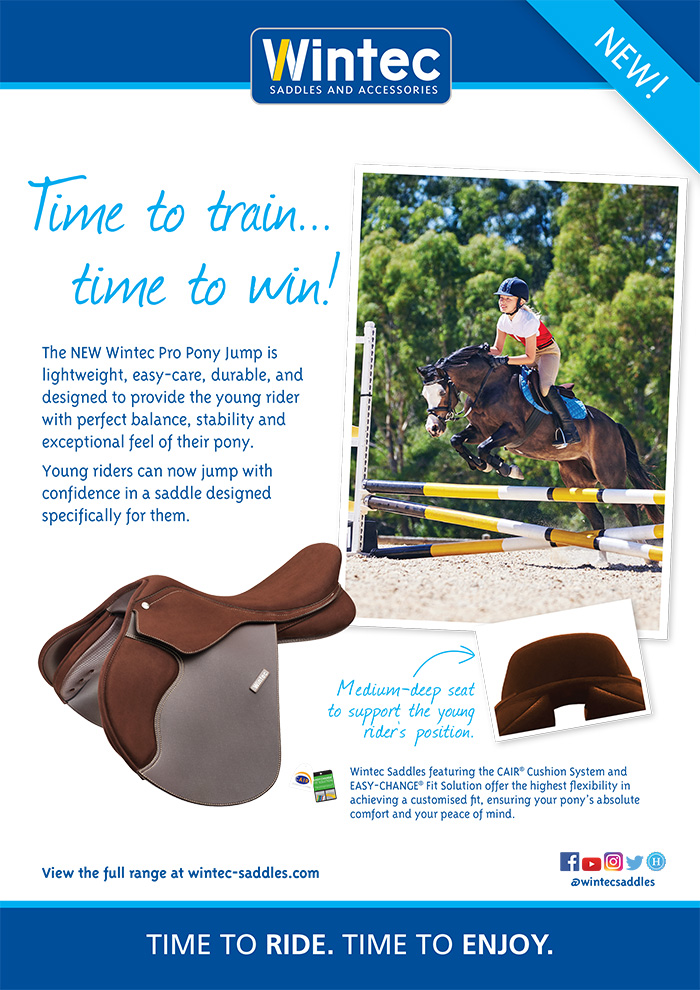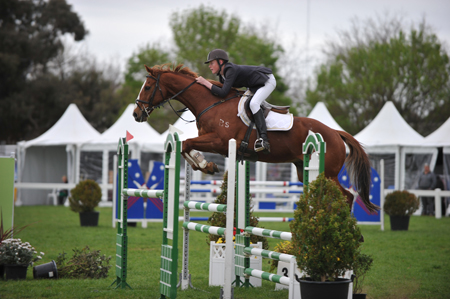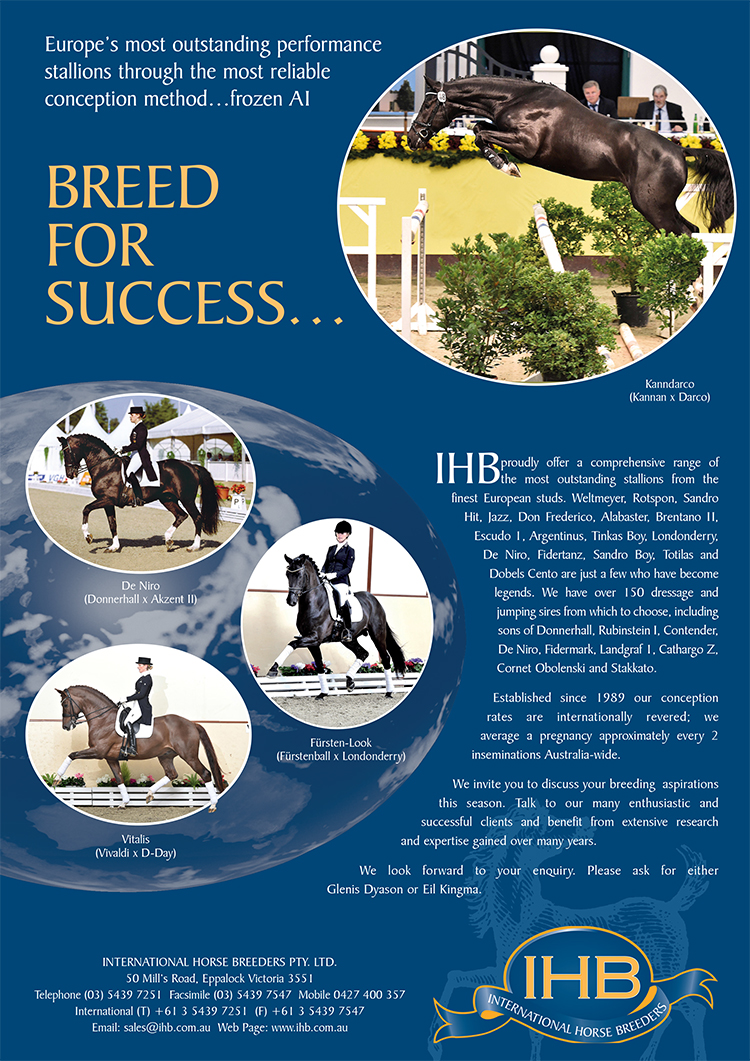
Story by Chris Hector & Photos by Roz Neave
Michelle and her crew ready to walk the course at the Australian Championships
When you see good teaching, really good instruction, you realise that it is both very simple and very subtle. Michelle Strapp is an exceptional trainer, with a string of successful students to prove it. Sit back and observe this lesson with exciting young showjumping talent, Sam Robertson. It’s simple, logical, progressive – but the way Michelle communicates these time-honoured principles is always fresh and original…
Sam is lucky, along with his older sisters, Melissa and Annica, he has been a regular student of Michelle’s and it shows in his riding. Sam is riding Smokey an 10 -year-old Warmblood gelding, owned by a friend. He’s getting Smokey ready for a shot at the Junior title at the Australian Showjumping Championships.
Michelle describes the horse as a ‘cheeky Warmblood’ and the rider as ‘a gun’ but a bit of a son-of-a-gun who is not entirely interested in perfecting his flatwork – not that he is going to get out of it.
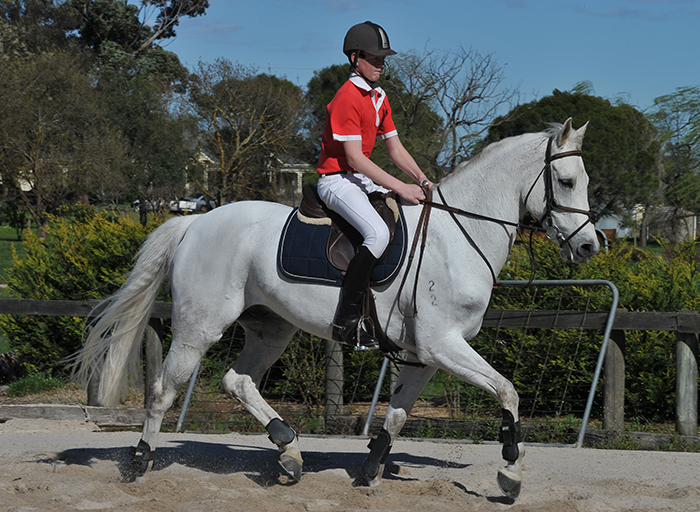
The young man has a very tidy secure seat, but Michelle wants him to think more about the way the horse is going in trot: “When you do a half-halt, try to keep the same tempo, you don’t want the motor to move away from you. Think about the activity of the hindquarters. You have the tendency with your young horse to try and make up for a loss of activity by riding him flatter and faster, watch out you are not doing the same with this horse.”
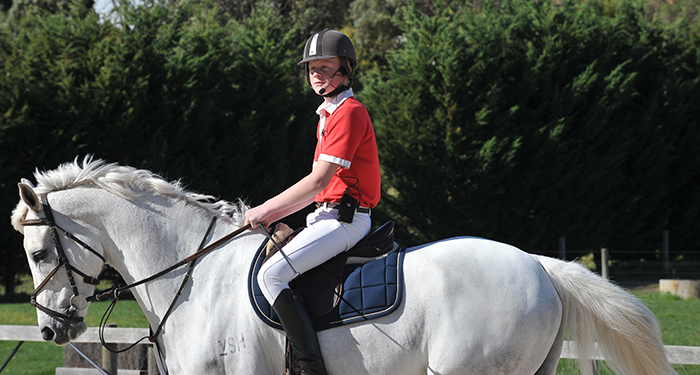
Have you been practicing enough riding in dressage length stirrups?
“Er, no.”
“We have a new goal for you, a whole hour of flatwork, without stirrups.”
more follows
Michelle comments that sometimes junior riders like Sam, who are successful and do well in events, can lose sight of the basics , or not understand the importance of them: “ Sam has had a wonderful season in juniors, he has a fabulous disposition in the ring, competition comes easy to him, however he has to be reminded not to be idle in the flatwork area.”
They are working on getting the horse softer and rounder:
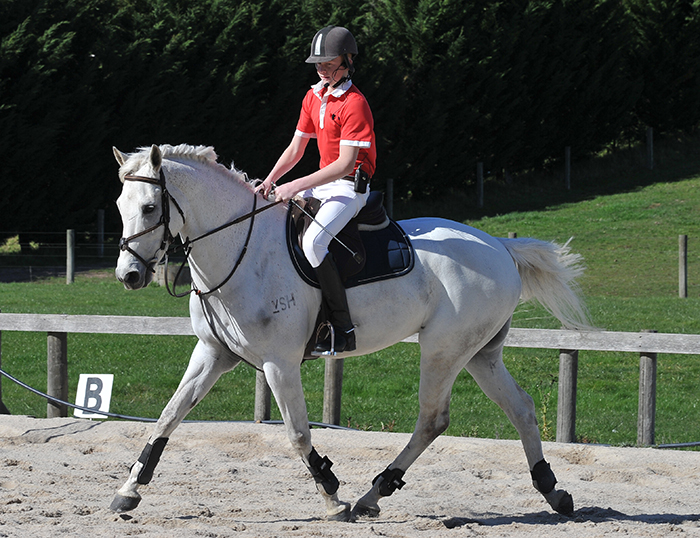
“When he feels inverted, don’t just pull his head in, soften his body. Think about what he is doing with his body. Now using your inside leg, enlarge the circle, but think about it like a nice curved line to a fence, we do not want him just bulging out of the circle with his shoulders. It’s not just about riding a circle, it is about being able to ride the line and speed in which you want to travel, keeping your horse’s four legs underneath him, and that is what jumping is all about: getting to the fence on a good line, good rhythm with a balanced horse. You might not like flatwork, so imagine there are fences in front of you on the circle, it gives you more insight and focus towards why you are riding shapes. If you can’t control these factors there is more room for error. You like winning, well that is why we doing flat work, so you can keep winning.
“So think about those two fences. Get your heels down, don’t round your back, you can relax your back, but don’t round it. Legs longer. Now, give after the half-halt, just let your arms go, you do not need to put a loop in the reins, just relax your arms.”
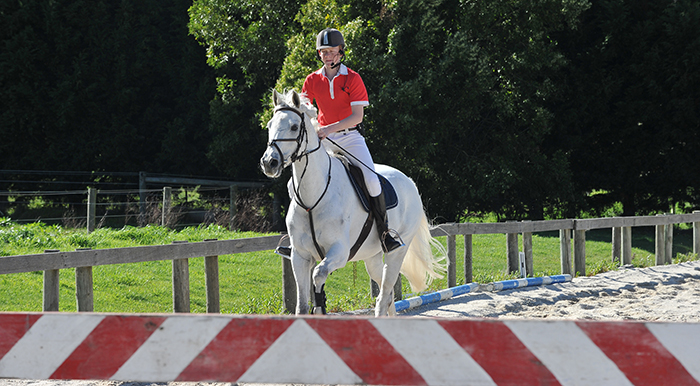
Always, the work on the flat relates directly to the work involved in jumping:
“Go for a little gallop, open the angle of your body to ride the circle. On course you could use up to 20 different angles of your body, it all depends on what is needed to balance your horse. The horse is falling to the inside and putting the weight on its shoulders. Bring your angle back to re-establish the balance and support him with your inside leg. The quicker you can re-establish the balance, the more prepared you are to meet the next fence. It is important for riders to become aware of their horse’s balance, you have to feel it, and correct it, a big bit alone will not do that, it is very hard for horses to jump off their front legs.
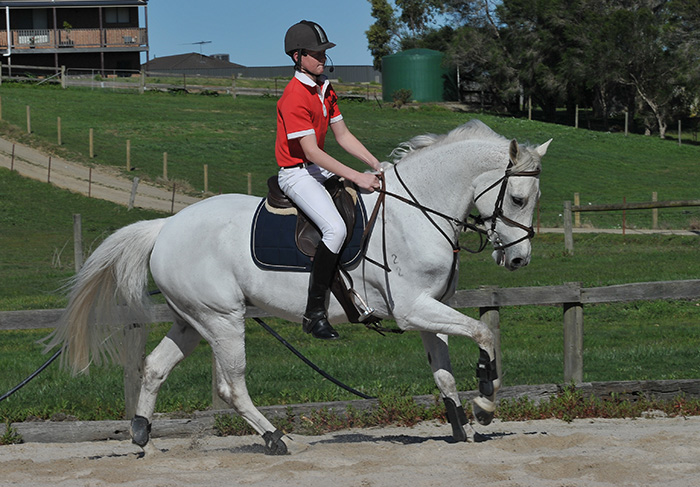
And the training techniques, the aids, need to be simple, clear, not busy aids, if they are to work on course, for instance, riding a flying change:
“For the flying changes, just think of keeping straight, find the spot you want to ride to, stay at the speed in which you want to travel, and keep straight. I do not want to see you twisting your body, pulling inside rein. That’s it, and look, the change just happens.”
It’s the time Sam has been waiting for – time to jump a few fences. There are some poles set up in front of a tiny vertical:
“Concentrate on keeping the horse straight, straight in the neck for the approach. Cluck, when you see a distance that is a little long, cluck and hold with your leg. Don’t get there by moving your body forward, you want the feeling that the horse is jumping up to you, you do not want to get ahead of the motion.”
Michelle is not happy with the way Sam rode the jump: “You made no choices at the pole. Three strides out you could see you had a half distance! Concentrate! Do something!! Whether your distance ends up a little short or a little long, what is important is your reaction to that distance.”
“Now we are going to ride a figure of eight, the vertical on the left rein and the oxer on the right rein, and be careful that his canter doesn’t get too short in the turns. Often he lands and his canter is running and out of balance, then when you get him back, the canter ends up too short. Get your body back, not to shorten the canter, but to get the balance back.”
This time, Michelle is happier with the jump, but… there is always a but.
“I loved that ride to the fence but your body did too much in the air, when you throw your body forward, you spoil the balance of the jump, it can make your horse quick off the ground and through the air. You are missing the flying changes because he is crooked and running, get your body back, keep his shoulders on the line in which you want to travel , then use your outside leg. See there, because you corrected his shoulders and balance, he changed.”
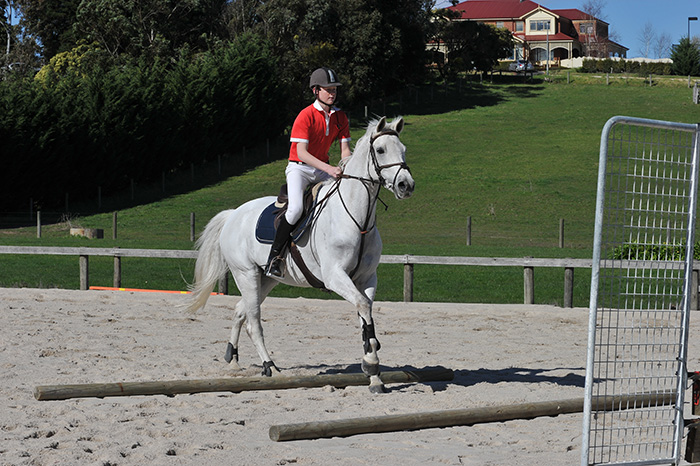
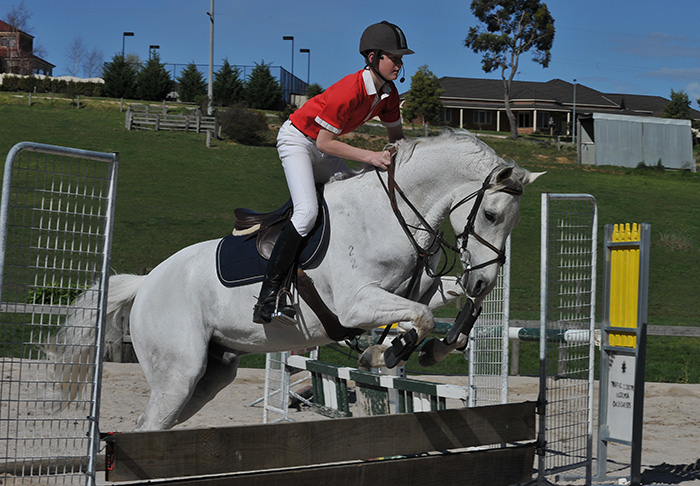
“Sometimes he is a little quick off the floor, just ride a good fence, balanced position and let him concentrate on the fence. He is careful enough, so he will learn to come away from the front rail. You have to be slower with your body off the floor. If the fence comes up a bit quick, concentrate on keeping his shoulders straight, do not let him shift across the fence, slow body and soft arms. Do not start twisting to find the flying change in between the two fences, you’ll find the change if you keep him straight. As you think about re-balancing, be careful you don’t let the horse fall behind you and lose the motor.”
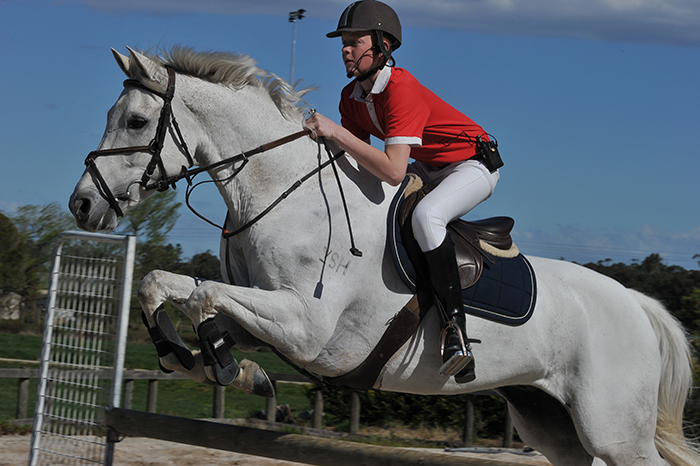
Sam jumps a little course :“My main criticism is that you are a fraction tighter with your hands than you need to be in the air. Don’t throw a release at him, just relax your arms on the last couple of strides, then you will follow the contact much better in the air. Don’t pull him off the ground at the verticals, you are protecting him from the front rail and it also makes the jump tight. You might do that at the last fence in competition, because you are hungry to win, and cannot help that instinct, but it is a big No No in training. Think about nice soft arms, don’t change the contact, just soft arms and keep the horse’s shoulders straight.”
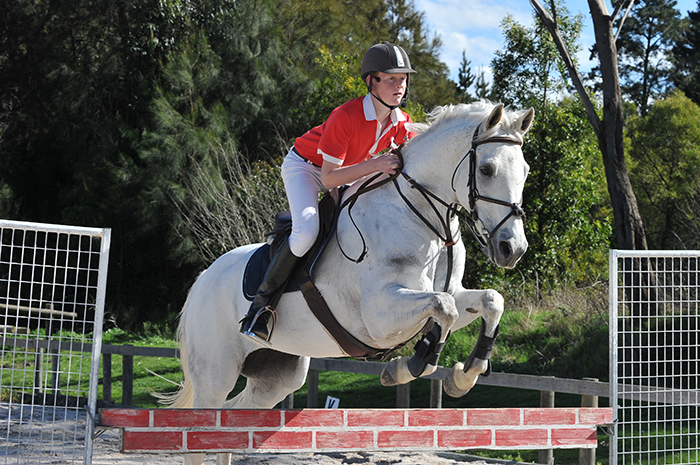
“Sit up, re-balance and think you’ve got another 20 fences to go… Do not finish the exercise or course sloppy. It has to be a natural instinct at all times to ride your horse in a canter that will successfully take you to the next fence, a unbalanced canter has no use to you.”
Michelle: “Sam is a good little rider, a very competitive rider and he has a wonderful disposition in the ring. He has a wonderful ability to ride young horses, I like to have him here to help me when I’ve got young horses to work, because he is very tactful. He doesn’t make a fuss about anything, just gets the job done.”
“He’s been riding with me since I don’t know how long… since he was 11 or 12, and he is 15 now. He is a super obedient pupil, very disciplined in that if I say to him, ‘go and do this exercise 20 times at home’, he’ll do it 20 times at home. The only thing we’ve just got to watch with him is how he moves through his career, because he is so competitive and he loves to be in the ring and jumping, so I do have to make sure I give him those exercises and he does his flatwork.”
Is it a problem now for young riders, that there are some super rich parents who will spend any amount to get their children the top horses… it’s hard for a youngster to get by with talent?
“It is hard, it’s not impossible but very tough – talent obviously helps but unless a rider like Sam is put on the right horses, he can’t be successful. The only benefit for these kids is that if they learn to ride and school horses, that gives them an added advantage because there are going to be a lot of young horses coming through. That gives them the opportunity to produce horses for breeders, owners, as well as their own. It is difficult though, as the standard goes up, the parents have to keep finding more and more money otherwise they are not going to be competitive.”
“It’s hard with Sam because both his sisters showjump, and their father works and works and works, trying to pay for horses, and all three are nice riders. Annica won the Showjumping Ambassador of the Year, this year – they are all nice, dedicated riders so Dad has to try and supply a team of horses for three kids. Tough.”
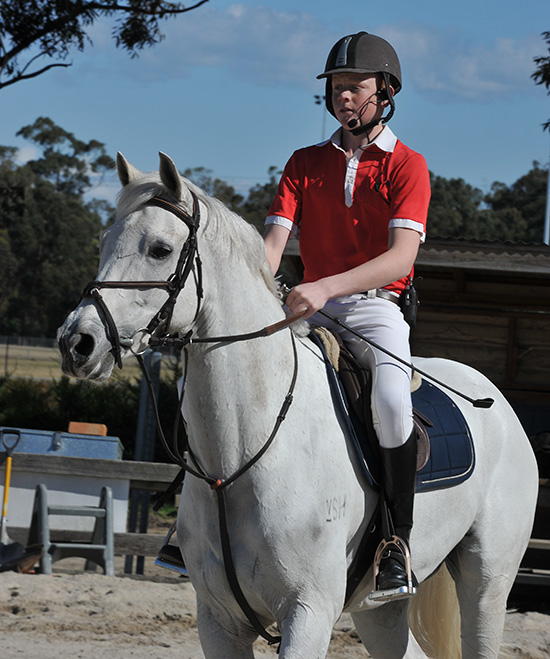
Sam, what do you like about showjumping?
“It’s a great sport. I love riding, I love jumping the jumps, it’s just good. I love the sport, I want to do it all the time. I’d like to do it full time when I am older and I think I will. I’m doing Year 9 at the moment, so I still have to do some school-work.”
Michelle has to keep after you to do your flatwork?
“I’d much rather jump than do my flatwork. At the moment I have four horses, two owned by other people and two of my own. I am kept pretty busy riding them all.
Sam placed at the Australian Championships on Tenterfield
George Sanna talks about buying Young Rider horses…
It seems to be an ongoing problem, horses with a little more experience are just not available – or affordable – and the young riders are having to ride horses that are green…
“It is a huge problem. Obviously the major constraint is budgetary. But even with a very significant budget, between 50 and 100 grand – which is significant, but not a European budget – it’s difficult. If you are talking about a highly competitive young rider, you want a horse that will deal with the mistakes that learning riders make, especially ambitious learning riders, like running against the clock and making dumb choices, to find a horse like that is very difficult. It’s got to be careful enough, certainly it’s got to be brave, athletic, rideable, a bunch of things.”
Is it easier to find them in Europe than Australia?
“Of course. Every sort of horse is easier to find in Europe but your budget in Europe starts pretty much where it tops out in Australia. Then you need another budget again, realistically speaking, we are talking 100 plus.”
Okay, we’ve mortgaged the house, we’ve got a budget, what do we look for – what qualities are essential, what can we compromise on?
“That depends entirely on the level of the rider. The first thing is that it has to ‘fit’ – young riders, especially ones who are ambitious and the ones we are talking about are competition riders who want to be competitive at a national level, are on a very steep learning curve at that time, and you have to be a little careful that you don’t find them something that is absolutely totally in their comfort zone, but within a very short space of time will not be competitive enough. In other words, it’s brave, it’s pleasant, it’s sweet and it is exactly what they need this week, but actually given that they are on a fairly strong forward trajectory in six, twelve months time, that horse won’t be quite competitive enough. It’s a really nice school master but not what they need down the track.”
“You have to understand what your client wants, what their expectations are, what their ambitions are, and then have a good feel for how they ride, what sort of horse they ride. Some people don’t ride hot horses well, some don’t ride cold horses well. Some smaller girls don’t ride big lumbering horses very well. You’ve got to get a feel for the horse that is going to do the job, then it has got to be sound enough to do the job.”
“What I find is that horsemen who have children at that stage, are much more accepting of soundness or age foibles, because they realise how hard it is to find the product. If you find absolutely the right one and it is a little old or needs a little management, they are used to that because they’ve had that in their past, and they know how to do it.”
Are you glad you were a young rider in the 60’s not now?
“In some ways yes. There was no Young Rider division then, we went straight from Junior to Open, and we didn’t suffer. If you look at that generation of riders, they are still clinging on as the major competitors in the country, or have just stepped away from it. We didn’t suffer, within a five year span there was a massive group of riders who came up through the old grading system, with no young riders, and riding crusty Thoroughbreds… all that sort of stuff, and we survived it.”
“The riders nowadays have got a massive leg in, in terms of how the sport is structured, on top of which they have an incredible range of good coaches to go to, which we didn’t have. In some ways it would be great to be a young rider now and be able to walk up to a coach and give them 80 or 90 bucks, and they spill their guts for an hour – all that they have learnt from bitter experience at two or three Olympic Games. That is amazing, you don’t have that access to top riders as trainers anywhere else in the world. So I think in many ways it is great to be a young rider now, but – BUT – the flip side of the coin is that now you need a much better horse and they cost money. It is tough on those riders who don’t have some coin behind them but at the same time, the ones with real talent do seem to find a way to get there.”

